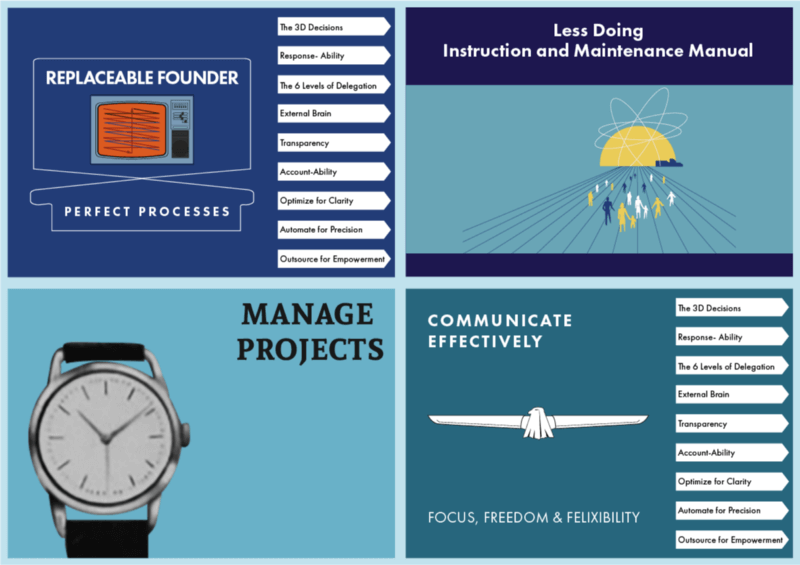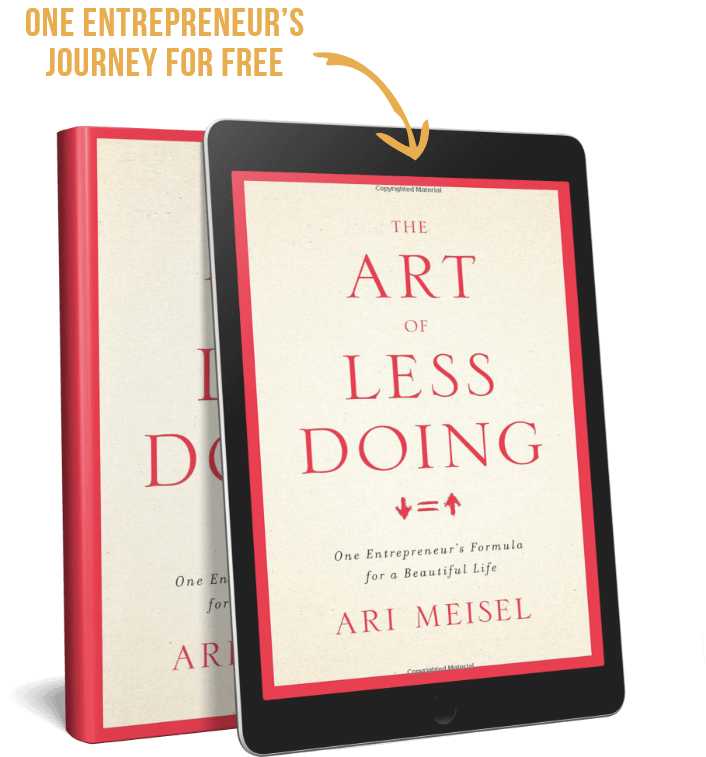What it was like, What happened, and What it’s like now
This blog post marks the 100th piece I’ve written here on Medium. So I figured it was time to tell you a little story about how we got started. You know to memorialize that sh*t.
Thanks, BTW, for reading and following and sharing and all those other modern metrics of support. I really appreciate it.
Here goes…
My name is Ari Meisel and I am the Founder of Less Doing — a coaching program that helps entrepreneurs who have opportunity in excess of what their infrastructure can support, find focus, flexibility, and freedom in their business.
My Replaceable Founder Methodology delivered through online courses, one-day intensives, and through our group coaching program, enables entrepreneurs to become replaceable so they can scale their business.
My podcast, The Less Doing Podcast recently published its 400th Episode and has been downloaded 1 million times.
Although I began coaching individuals who were hungry for greater productivity for a long time now, I began coaching businesses in earnest two years ago. Our first year we hit the million-dollar revenue mark and we are on pace to surpass that this year.
But it’s a metric I don’t embrace as much as the results our clients get when they follow my Methodology. That’s success to me.
The Backstory
Imagine this. You’re 20 years old, you’re working on a project that you’re spending 18 hours a day, you’re young, you’re full of energy, full of vigor, and you’re working nonstop 18 hours a day. Hard-charging, being super productive, and three years of doing that, you find yourself with a chronic illness, and it nearly kills you. All the while, you’re building up debt and not getting things done. This chronic illness takes you from working 18 hours a day to barely struggling to get an hour of work on any given day. What do you do? I think most people would probably give up.
Or…
You find a new way of doing things in that one hour that you have.
Now, that was me when I got diagnosed with Crohn’s disease, and my response to that was creating a brand new system of productivity that would allow me to get a maximum amount done, actually more than I’d ever gotten done before in much less time.
If you ask somebody, who works a nine to five job, “what would you do? If you could only work till four? The answer is easy, “skip lunch,” but if you ask that same person, what would you do if you only had an hour of the day to get that work done?
It requires an entirely different kind of thinking. One that most people are not even aware of because the question isn’t what would you do? It’s what wouldn’t you do? If those things that you wouldn’t do still have to get done, who or what is going to do them for you?
The whole idea of working smarter versus harder is particularly relevant here. No time restriction says you can not be more productive. It does not exist. I’ve seen so many different situations where people thought that they had no more time, and the time was their problem. Time is never the problem. It’s just about how you use it.
And that’s how I came up with the idea for Less Doing and The Replaceable Founder Methodology.https://upscri.be/6892b4?as_embed=true
Back in the day
I began helping people with their personal productivity and launched a product called “Overhwhelmology 101 attached here http://less.do/iqwyHI
It quickly morphed into a more business-centric product and The Replaceable Founder Methodology was born. Honestly, I thought I needed more team members, more software, more everything in the beginning, but then I started employing my own Methodology and things got pretty optimized, automated, and outsourced really fast.
One of the biggest things we learned when we were just starting out is that the best way to build a scalable, automated business organization is to break it up into pieces. An early mistake we made was investing thousands of dollars into an “all-in-one CRM” — it ended up being completely useless to us and continues to sit there gathering dust.
A smart, automated business has multiple moving parts which specialize in different business functions in your organization. Not only does this allow you to handle each business unit well, it also makes debugging easier — you have multiple points of failure that you can dive into rather than a single, massive, messy monolith.
For example, one of the companies we work with, ContentFly, has 73 different zaps running their entire platform AND company. 73! They have more zaps than they have lines of code.
People underestimate the sheer amount of powerful tools that are available, all flawlessly efficient.
Slack and Zapier is where it all begins — Slack should be the command center of your operation, with Zapier being the pipes that bring all the other services in, allowing you to manage/monitor it from one place.
After that, it’s entirely up to you. Airtable is our weapon of choice, and Typeform is a great way of creating front-end or lead-in interfaces. Stripe & PayPal can handle your payments, while MailChimp and Intercom can automate customer marketing & communication.
If you aren’t using all of these touchpoints, in favor of just one catch-all system, you’re missing out on so much value. Each of these tools does their own specialization in a way that no catch-all will ever accomplish.
All told, we haven’t even brought up the best part of this: synergy.
By enabling multiple touchpoints, you can actually enhance the capabilities of each individual one. Zapier, for instance, has several Built-in Apps that let you format, filter & transform data before moving them from service to service.
You can literally automate everything.
Why give up that incredible power just to get hamstrung to a single tool? It’s an age-old mindset and a lazy one — if you aren’t aggressively fine-tuning your processes and building a machine that can scale, you’re planning your own obsolescence.
How it Works
There’s one question I get asked by entrepreneurs all the time:
What’s the most important thing I can invest my money and resources to make sure my business grows?
If you’re an entrepreneur, you’ve probably asked yourself the same. I know I have.
It always seems like there’s not enough money or time to allocate to all those important things. And that’s problem number one.
Problem number two is that there’s no one-size-fits-all solution that’s going to help every entrepreneur out there.
The answer depends on the stage your business is currently at.
If you’re running a 100k MRR business and spending 80% of it on overhead costs, you’re probably going to want to automate as many tasks as possible.
On the other hand, if you’re only starting out and your business is still your side hustle, you’re going to need to get profit to make it full-time. Fast.
9 Stages of Growth
We’re going to be using Alex Charfen’s data for different stages of entrepreneurial growth.

Alex sums up the process nicely. Each stage of your business’ growth needs different things, so responding to a question of what you should invest in now depends on what your business needs now.
Growing Your Side Hustle to a Business
This is the first stage of the entrepreneurial journey. Usually, before we reach the $100,000 mark, we’re still at the part-time mark and our businesses are side hustles we’re looking to grow.
The main thing to do at this stage is finding product-market fit.
What does this mean? Should you invest in tech?
No.
All you need to do at this stage is put out feelers and see how people (the market, your audience) respond to your idea.
Let’s say you’re developing a new product that’s going to help 20–30-year-olds develop their careers much faster than with traditional channels.
You need to get out there and tell them about your idea.
You need to talk to your audience and see whether they think it’s useful and whether they even understand why they need your product.
The best thing to invest your money and resources into at this stage is creating content.
Create content that’s going to reach and resonate with your audience. This can be blog posts, eBooks, videos, webinars — anything that adds more value.
Content is king, after all.
For example, I’m doing it with Facebook Lives to get in touch with the people who are my target audience, and to understand how I can develop my product to best serve their needs (product-market fit is all about that).
I’m still agile in my approach so I can change strategies and adapt my product to what my audience responds best to.
If you invest in tech at this stage, you’re still unsure of the product-market fit, and the chances of losing money by investing into the wrong thing are very high. It’s better to get in touch with your future customers and find the ones who need your product or educate them.
Of course, you can also add people to your mail list with tools like MailChimp which are free for up to 2,000 subscribers.
And this is another perk of creating awesome content — people will want to read more, they’ll want to stay informed on what you’re doing.
Promoting Your Ideas
When you’re at the $100,000 mark, that’s when you should start asking people if they’d like what you have to offer.
By then, you’ve gained their trust with valuable content.
And your main mission at this stage is spreading your voice, promoting your content even more until you’ve grown from $100,000 to $300,000.
If you want to invest in something when you’ve got quality foundations like the ones you’ve set with content, invest in technology that’s going to help you reach even more people.
Next Stop: Leveraged Sales
The next stop is definitely sales.
Sell as much as possible.
You’ve found the right kind of customers, motivated them with content, and it’s time to leverage that (and tech) to get sales.
If you’re doing it right, you may find that the best thing to invest in here is automating your sales process.
Why?
You want to be focusing on scaling your business and increasing sales, and you can’t do that if you’re still doing everything manually. That’s why we need some degree of automation to get leveraged sales.
Yes, I often talk about not needing CRM systems (customer relationship management systems) but they can be a good fit if you’ve got specific needs.
If you need something right now, improvise a CRM system to get leveraged sales with Trello and Zapier.
You can create corresponding boards with Trello, and automate the process with Zapier. The best thing is that you can get a lot of automation done with just free accounts.
For streamlining bookings and learning more about clients’ unique needs, check out Calendly.
At this stage of your business’ growth, you need to introduce some degree of automation to be able to generate even more revenue.
Creating Systems & Processes
Once you’re en route from $300,000 to $1 million, you can no longer say that you’ve got limited funds.
However, your needs change. You no longer need to push as hard on sales manually, or focus on getting your content out there.
What you need are systematization and processes.
You want to create systems and processes that reflect the methods that helped you reach this level of success. If you want to replicate them and use them to fuel your future growth, you need to make a system out of these behaviors and methods.
This is the point where you get a bit more into automation. You use software like Process Street to help you understand, organize and optimize your process and workflow.
You may also need more advanced communication systems to keep everything up and running successfully. Usually, entrepreneurs use Slack to communicate with their teams, and Intercom to communicate with customers.
The main goal of this stage is understanding what methods led you to success, and turning them into systems that will keep the machine going, bringing you even more revenue as you focus on different strategies.
Do We Need Tools to Grow as Entrepreneurs?
Honestly?
No.
You can reach your million in revenue without spending a single cent on tech, but it can be time-consuming. That’s why I encourage tech in moderate amounts to make the workload easier.
However, the main thing to remember is that you have to focus on things that bring immediate value and explain the benefits of your business for your potential customers.
After that, conversion becomes a piece of cake.
What It’s Like Now
Every week our small but mighty team gathers for a huddle call to check in about our monthly, weekly and daily goals and tasks.
If you’ve ever been to one of my Replaceable Founder Intensives, you know that we use Trello as our project management tool and as our focal point for weekly and monthly team meetings.
We sort the tasks assigned in Trello by team members and then each person gives an update on progress. It’s transparency and accountability in action. Every week. No excuses. So it’s not at all like this book club I used to go to where all we ever talked about is how we didn’t have time to read the book.
So, at this week’s meeting, Courtney our awesome COO shared her screen and the sorting and updating began, starting with her 25+ tasks. Then she shared what Joanna and The Amys are accountable for, and each of them had at least 20 tasks populating the screen. I love Trello for this; with each team member shuffle, the screen fills with a new assortment of color-coded “cards” that describe the array of responsibilities each team member is in charge of.
(And, of course, each of these responsibilities equates to critical things that move the growth of the business forward.)
Lots of responsibilities mean lots of cards on the screen in front of us.
Then Courtney came to me…
She shuffled the cards again to reveal my activities for the week and suddenly the screen went from covered with cards to cleaner than Marie Kondo’s kitchen counter.
I had TWO, that’s right TWO critical items assigned to me:
- Record a podcast episode.
- Transfer my profit sharing from the business account to my personal account.
Yup. That’s it. Record my thoughts and take money out of the bank. That’s all I had to do this week to keep the business moving forward.
This is how it’s been lately.
I am doing less and less as it relates to the minutiae of the operation of the business and doing more and more as it relates to me simply being, for lack of a better word, the Inventor.
These days I’m pretty much just showing up as “the talent” for the business. I give talks, I show up on podcasts and give interviews. I meet with potential partners to explore larger growth opportunities for the company.
Do you know why I’m able to do this?
Well, we all agreed it’s because I am getting out of the way. I’ve put systems and processes into place that work insanely well without me.
I have become replaceable.
Can I get a “Hell Yeah”?
And here’s the kicker . . .
We had our best profit month ever last month, all because I’ve been able to successfully get out of the way and let my team do what they do best.
The less I do, the better the company is performing.
Let me say that again so it really sinks in for you because I know this is sometimes a hard concept to grasp…
I’m the founder and CEO and our numbers are proving to us that the less I do, the better the company is performing.
This scenario has been the dream for me too for a long time. It’s taken a lot of trial and error to get us here, and we’re still ironing out the edges, but it works, this Methodology I created. I have become my own best case study.
Life Lessons Along The Way
Work-Life Balance is something that comes up all the time and I’ve said many times before that I do not believe in work-life balance.
I particularly like Alain deBotton’s treatment of this where he says that there is no such thing as work-life balance because anything that is worth pursuing will take us out of balance.
We try so hard all the time to make it so everything’s good and everything’s right and it always seems so fleeting…because it is. I think we need to accept that sometimes in some way for some period of time, there will be things in our life that don’t work well.
When you think about the things in your life, it could be your business, your friends, your family, your children, your parents, your physical health, whatever it might be. To think that we can have all those things in line is crazy and sets us up for failure.
We live in a society where success is celebrated relentlessly and ordinary achievement is completely overlooked; even though ordinary achievements are all around us all the time.
I got all four kids in snowsuits and boots in less than twenty minutes, last winter. I brought a plant back to life. I made peace with my Dad. What is amazing for one person is not realistic for another person and also not necessarily what amazing looks like for them.
As entrepreneurs, we put ourselves in uncomfortable situations on a regular basis. Comfort for us is a very bad thing. It makes us complacent, it makes us bored. In some cases, it makes us self sabotage and we can actively seek experiences that make us uncomfortable.
Life assures us time and time again, that it will go out of balance. But we have the chance to fix it, amend it, change it. There’s always something with which to tinker. Always.
Tech Helps
Here’s a link to our tech stack https://gumroad.com/l/ldfree/ldfree
So Does Inspiration

Best Advice I Got.
Lean into doubt.
I’m NOT talking about self-doubt. No way. That stuff sucks. Self-doubt is a lack of confidence, tanking self-esteem, and a negative, albeit, egotistical way of looking at the world. It translates into, “Well, I know I’m messing up, I’m not going to do the right thing, but the world still revolves around me and my decisions.” Toxic shit.
No, I’m talking about doubt as an agent of change. It can be a middle finger to the status quo and honest interrogation of why people around you “always do it this way.” The push back you’ll inevitably get from that heels dug in mentality should be your invitation to doubt even more.
If you question or doubt, a system, decision, policy or process which others are fully invested. If someone in a position of authority feels challenged by your doubt, stuff will get stirred up and brought out into the open.
In the words of my favorite Jurist, Louis Brandeis,
“Sunlight is said to be the best of disinfectants;”
Things will change. Now I’m not saying that they will always change for the better. We need to put ourselves in a position to do the work, question the thinking, offer alternatives, and let the results go.
It is how we build up our doubt muscle.
We do not attach ourselves to the outcome. We take pride in our investigation, in our curiosity, and our questioning. When we do this, we get better at the doubt game. Our questions become more pointed. We allow others to see the problems, not as something of their making, or their fault, but as an opportunity to get on the doubt train with you and develop more innovative solutions.
Where can you go to learn more?
Website: https://lessdoing.com/
Linkedin: https://www.linkedin.com/in/arimeisel/
Facebook: https://www.facebook.com/arimeisel
Twitter: https://twitter.com/arimeisel




